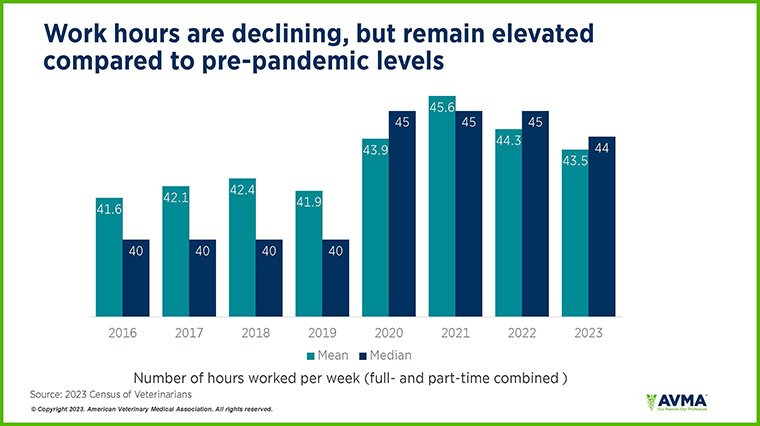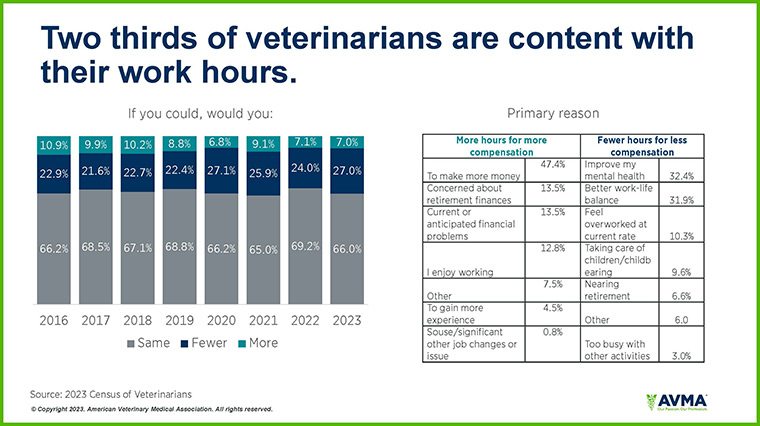Veterinarian salaries struggle to keep up with inflation
Updated November 3, 2023
The mean veterinarian income actually saw a slight decline when accounting for inflation, going from $147,787 in 2021 to $146,782 in 2022 (using 2022 dollars). The annual inflation rate for the U.S. was 6.5% last year.
Unlike new veterinarians, overall veterinary incomes haven’t quite caught up to prerecession levels, said Charlotte McKay, AVMA associate director for statistical and geospatial analysis and senior economist.
However, competition in the market for veterinarians and inflation have contributed to a rise in salaries, she said during the presentation “The Market for Veterinarians” at the annual AVMA Business and Economic Forum, held virtually October 24-25.
Workplace
Of course, variation exists across different practice types and between owners and associates. For example, the lowest mean salary in 2022 among all private practice types was for food animal associate veterinarians at $95,000; however, food animal veterinarian owners had the highest mean salary at $225,000.
The mean salary in 2022 for companion animal associate veterinarians was $141,000 and for companion animal veterinarian owners it was $191,000.
Veterinarian work hours are declining overall, but remain slightly above pandemic levels, McKay said. In 2020, veterinarians worked an average of 43.9 hours per week compared with 43.5 hours per week in 2023. These figures account for both full-time and part-time veterinarians.
Two-thirds of veterinarians are content with their work hours while 7% would work more if they could. Twenty-seven percent of veterinarians say they would work fewer hours for less compensation. The two main reasons cited were to improve mental health (32.4%) and better work-life balance (31.9%).
Employment
McKay said the job market is cooling. The national unemployment rate remains low at 3.8%. With interest rates remaining high and the economy potentially slowing down, projections say the unemployment rate will reach 4.7% by the end of 2024.
In veterinary medicine, unemployment rate was 0.5% in 2023, which was the same rate as 2022. This does not include veterinarians who are not seeking employment and are not retired. These folks account for 1.6% of the profession.
Ninety-one percent of veterinarians say they have either never considered leaving the veterinary profession (53%) or they considered but decided to stay (38%), according to results from the 2023 Census of Veterinarians.
Of the 9% who say they are considering leaving, nearly half (48.3%) said the primary reason would be to better their mental health or improve their lifestyle or work hours.
Demographics
Nearly two-thirds (62%) of the veterinary profession are female and a little more than one-third (38%) are male. Almost three-quarters of women veterinarians are in companion animal practice (73%) compared with 65% of male practitioners.
Both genders account for about an equal percentage in equine—4% for female and 5% for male—but men comprise a greater percentage of food animal practitioners at 8% of veterinarians compared with 1% of women.
As for race, 89.3% of the profession is white, while the remaining 10.7% is minority, including Hispanic (4.1%), Asian (2.5%), and Black (1.2%). That’s an increase from 8% minority veterinarians in 2019.
McKay also pointed out that those from underrepresented races and ethnicities accounted for about 5% of the veterinary student population in 1980 compared with 25% in 2023, according to the American Association of Veterinary Medical Colleges’ 2022-23 annual data report.
A version of this story appears in the December 2023 print issue of JAVMA.
Related content
New equine practitioners’ salaries see big increase
Economist gives big-picture view of economy, veterinary profession
Report: Animal health industry experiencing highly competitive labor market
For most practices, demand returns to pre-pandemic levels
Veterinarian employers require innovative solutions to attract, retain staff members




